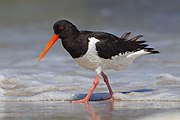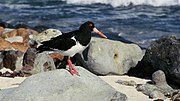| Oystercatchers Temporal range: Middle Miocene – Recent PreꞒ Ꞓ O S D C P T J K Pg N | |
|---|---|

| |
| Pied oystercatcher (Haematopus longirostris) | |
| Scientific classification | |
| Domain: | Eukaryota |
| Kingdom: | Animalia |
| Phylum: | Chordata |
| Class: | Aves |
| Order: | Charadriiformes |
| Suborder: | Charadrii |
| Family: | Haematopodidae Bonaparte, 1838 |
| Genus: | Haematopus Linnaeus, 1758 |
| Type species | |
| Haematopus ostralegus Linnaeus, 1758 | |
| Species | |
|
Twelve, see table | |

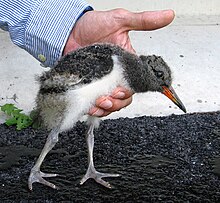
The oystercatchers are a group of waders forming the family Haematopodidae, which has a single genus, Haematopus. They are found on coasts worldwide apart from the polar regions and some tropical regions of Africa and South East Asia. The exceptions to this are the Eurasian oystercatcher, the South Island oystercatcher, and the Magellanic oystercatcher, which also breed inland, far inland in some cases. In the past there has been a great deal of confusion as to the species limits, with discrete populations of all black oystercatchers being afforded specific status but pied oystercatchers being considered one single species.
Taxonomy
The genus Haematopus was introduced in 1758 by the Swedish naturalist Carl Linnaeus in 1758 in the tenth edition of his Systema Naturae to accommodate a single species, the Eurasian oystercatcher Haematopus ostralegus. The genus name Haematopus comes from the Ancient Greek words haima αἳμα meaning blood, and pous πούς meaning foot, referring to the red legs of the Eurasian oystercatcher; it had been in use since Pierre Belon in 1555. The family Haematopodidae was introduced (as the subfamily Haematopodinae) by the French naturalist Charles Bonaparte in 1838.
The common name oystercatcher was coined by Mark Catesby in 1731 for the North American species H. palliatus, which he described as eating oysters. The English zoologist William Yarrell in 1843 established this as the preferred term, replacing the older name sea pie, although the term had earlier been used by the Welsh Naturalist Thomas Pennant in 1776 in his British Zoology.
Description
The different species of oystercatcher show little variation in shape or appearance. They range from 39–50 centimetres (15+1⁄2–19+1⁄2 inches) in length and 72–91 cm (28+1⁄2–36 in) in wingspan. The Eurasian oystercatcher is the lightest on average, at 526 grams (1 pound 2+1⁄2 ounces), while the sooty oystercatcher is the heaviest, at 819 g (1 lb 13 oz). The plumage of all species is either all-black, or black (or dark brown) on top and white underneath.
The variable oystercatcher is slightly exceptional in being either all-black or pied. They are large, obvious, and noisy plover-like birds, with massive long orange or red bills used for smashing or prying open molluscs. The bill shape varies between species, according to the diet. Those birds with blade-like bill tips pry open or smash mollusc shells, and those with pointed bill tips tend to probe for annelid worms. They show sexual dimorphism, with females being longer-billed and heavier than males.
Feeding
The diet of oystercatchers varies with location. Species occurring inland feed upon earthworms and insect larvae. The diet of coastal oystercatchers is more varied, although dependent upon coast type; on estuaries, bivalves, the ivygastropods and polychaete worms are the most important part of the diet, whereas rocky shore oystercatchers prey upon limpets, mussels, gastropods, and chitons. Other prey items include echinoderms, fish, and crabs.
Breeding
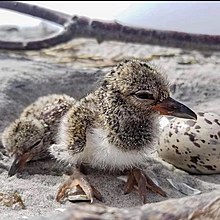
Nearly all species of oystercatcher are monogamous, although there are reports of polygamy in the Eurasian oystercatcher. They are territorial during the breeding season (with a few species defending territories year round). There is strong mate and site fidelity in the species that have been studied, with one record of a pair defending the same site for 20 years. A single nesting attempt is made per breeding season, which is timed over the summer months. The nests of oystercatchers are simple affairs, scrapes in the ground which may be lined, and placed in a spot with good visibility.
The eggs of oystercatchers are spotted and cryptic. Between one and four eggs are laid, with three being typical in the Northern Hemisphere and two in the south. Incubation is shared but not proportionally, females tend to take more incubation and males engage in more territory defence. Incubation varies by species, lasting between 24–39 days. Oystercatchers are also known to practice "egg dumping." Like the cuckoo, they sometimes lay their eggs in the nests of other species such as seagulls, abandoning them to be raised by those birds.
Conservation
The Canary Islands oystercatcher became extinct during the 20th century. The Chatham oystercatcher is endemic to the Chatham Islands of New Zealand and is listed as endangered by the IUCN, while both the African and Eurasian oystercatchers are considered near threatened. There has been conflict with commercial shellfish farmers, but studies have found that the impact of oystercatchers is much smaller than that of shore crabs.
Species
The genus contains twelve species. Species in taxonomic order:
| Common name | Scientific name and subspecies | Range | Size and ecology | IUCN status and estimated population |
|---|---|---|---|---|
| Magellanic oystercatcher | Haematopus leucopodus Garnot, 1826 |
Southern South America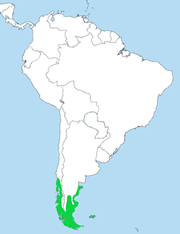
|
Size: Habitat: Diet: |
LC
|
| Blackish oystercatcher | Haematopus ater Vieillot & Oudart, 1825 |
South America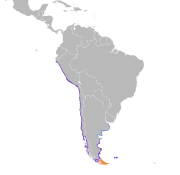
|
Size: Habitat: Diet: |
LC
|
| Black oystercatcher | Haematopus bachmani Audubon, 1838 |
West coast of North America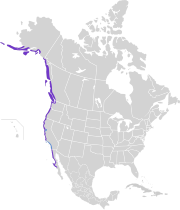
|
Size: Habitat: Diet: |
LC
|
| American oystercatcher | Haematopus palliatus Temminck, 1820 |
North and South America
|
Size: Habitat: Diet: |
LC
|
| † Canary Islands oystercatcher | Haematopus meadewaldoi Bannerman, 1913 |
Canary Islands | Size: Habitat: Diet: |
EX
|
| African oystercatcher | Haematopus moquini (Bonaparte, 1856) |
Southern Africa
|
Size: Habitat: Diet: |
LC
|
| Eurasian oystercatcher or Palaearctic oystercatcher |
Haematopus ostralegus Linnaeus, 1758 Four subspecies |
Europe, Asia and northern Africa
|
Size: Habitat: Diet: |
NT
|
| Pied oystercatcher | Haematopus longirostris Vieillot, 1817 |
Australia
|
Size: Habitat: Diet: |
LC
|
| South Island oystercatcher | Haematopus finschi Martens, 1897 |
New Zealand
|
Size: Habitat: Diet: |
LC
|
| Chatham oystercatcher | Haematopus chathamensis Hartert, 1927 |
Chatham Islands | Size: Habitat: Diet: |
EN
|
| Variable oystercatcher | Haematopus unicolor (Forster, 1844) |
New Zealand
|
Size: Habitat: Diet: |
LC
|
| Sooty oystercatcher | Haematopus fuliginosus Gould, 1845 |
Australia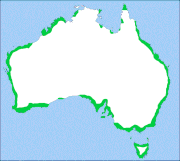
|
Size: Habitat: Diet: |
LC
|
Several fossil species are known, including Haematopus sulcatus (Brodkorb, 1955) from the Barstovian of Florida and Zanclean of North Carolina, and which is evidently considered a synonym of the extant species Haematopus palliatus.
References
- ^ Hockey, P (1996). "Family Haematopodidae (Oystercatchers)". In del Hoyo, J.; Elliot, A. & Sargatal, J. (editors). Handbook of the Birds of the World. Volume 3: Hoatzin to Auks. Lynx Edicions. ISBN 84-87334-20-2.
- Linnaeus, Carl (1758). Systema Naturae per regna tria naturae, secundum classes, ordines, genera, species, cum characteribus, differentiis, synonymis, locis (in Latin). Vol. 1 (10th ed.). Holmiae (Stockholm): Laurentii Salvii. p. 152.
- Jobling, James A (2010). The Helm Dictionary of Scientific Bird Names. London: Christopher Helm. p. 184. ISBN 978-1-4081-2501-4.
- Belon, Pierre (1555). L'histoire de la natvre des oyseavx : avec levrs descriptions, & naïfs portraicts retirez du natvrel, escrite en sept livres (in French). Paris: Gilles Corrozet. p. 203.
- Bonaparte, Charles Lucien (1838). "Synopsis vertebratorum systematis". Nuovi Annali delle Scienze Naturali, Bologna (in Latin). 2: 105–133 .
- Bock, Walter J. (1994). History and Nomenclature of Avian Family-Group Names. Bulletin of the American Museum of Natural History. Vol. 222. New York: American Museum of Natural History. pp. 139, 229. hdl:2246/830.
- ^ Lockwood, W.B. (1984). The Oxford Book of British Bird Names. Oxford: Oxford University Press. p. 113. ISBN 978-0-19-214155-2.
- Catesby, Mark (1729–1732). The Natural History of Carolina, Florida and the Bahama Islands (in English and French). Vol. 1. London: W. Innys and R. Manby. p. 85.
- Yarrell, William (1845). A History of British Birds. Vol. 2. London: J. Van Voorst. p. 496.
- Pennant, Thomas (1776). British Zoology v.2. London: Benjamin White. pp. 482–483.
- John B. Dunning Jr. (1992). CRC Handbook of Avian Body Masses. CRC Press. p. 98. ISBN 978-0-8493-4258-5.
- "Birds Dumping Eggs on the Neighbors". Sciencedaily.com. 2011-06-03. Retrieved 2012-12-20.
- Gill, Frank; Donsker, David; Rasmussen, Pamela, eds. (July 2021). "Buttonquail, thick-knees, sheathbills, plovers, oystercatchers, stilts, painted-snipes, jacanas, Plains-wanderer, seedsnipes". IOC World Bird List Version 11.2. International Ornithologists' Union. Retrieved 18 August 2021.
- Haematopus palliatus Temminick 1820 (American oystercatcher) at FossilWorks
External links
- ARKive – images and movies of the oystercatcher (Haematopus ostralegus)
- Oystercatcher videos on the Internet Bird Collection
- LIVE webcam at the seashore in Namsos, Norway 2013
| Taxon identifiers | |
|---|---|
| Haematopus |
|






